
Update: I am currently updating this gear list for 2022/2023. Bear in mind that I may not have used the gear suggested. They are only suggestions.
I thought I had a pretty good idea about the gear I needed prior to my 2018 thru-hike of the PCT. As it turned out, I changed out over 90% of my original gear list. The good thing was that it was relatively easy to acquire new gear along the way. Keep in mind that the following is not a definitive list, it’s just based on my experience. There are a lot of different opinions and choices out there, and more than one way of looking at things.
When reading my review or the review of others, also keep in mind that there is a big difference between an average person completing a PCT thru-hike in about 5 months versus someone who has the capability to finish it in 3 months. A fast person will cover the PCT during the warmest Summer months and can get away with a lighter sleeping bag, pad, etc. The average person, like me, will start sometime in Spring and finish sometime in Autumn. The colder shoulder seasons outside of summer may require warmer gear.
One last point I’d like to make is that there is a difference between backpacking and thru-hiking. Backpacking is centered around having fun, and thru-hiking, at some point for me, stopped being fun (at least for while!) and I became focused on making big miles to cover as much ground as possible. That means having the lightest, most efficient gear possible. I won’t carry a 2-person tent for ‘extra room’ when I spend so little time in it, and most importantly, a 1-person tent is going to be a couple of ounces lighter. It may not be much, but those ounces add up. I’ve never regretted my decision to go with a lighter but smaller, more efficient tent.
Sleeping Bag
I started out with the Enlightened Equipment Revelation Quilt, 20 degree, reg/wide. First of all, I had bought the wrong size. It was too long and too wide, and there was just too much dead air space in the bag for my body to warm up. I should have gone with a short/reg, or maybe even a short/slim. However, I think that EE’s temperature rating was a little too optimistic. Also keep in mind that the temperature ratings for quilts are generally calculated using an integrated hood from that company, and if you are not using that hood, you may not achieve the same warmth.
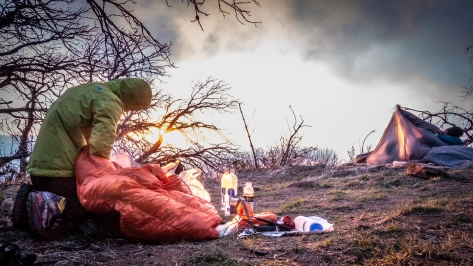
I switched to a Western Mountaineering Ultralite 20 Degree Sleeping Bag which served me well for the rest of the trip. If I were to do the PCT again, I would be tempted to try a quilt again to save some weight. Keeping in mind that I would need to add a puffy hood, the weight savings are reduced. The Katabatic Gear Alsek 22 looks like a good choice for me, or I might try the Enlightened Equipment Enigma 10 Degree or Zpacks Solo 10 Degree, and the hood.
I don’t use a liner. That’s just an item that’s not very efficient, weight wise. To keep my sleeping bag clean, I wipe myself down at the end of the day and change into my leggings, long sleeve shirt, clean socks, and wear my buff on my head to sleep in. Nevertheless, it would be a good idea to wash your sleeping bag, and other down gear at least once during your thru-hike.
Update for 2020:
There have been significant changes this year for some prominent quilt manufacturers. Enlightened Equipment have increased their amount of fill (again!), Zpacks have made their footbox bigger, and Katabatic quilts are now made in China, and have lower prices.
For a typical 5-month long thru-hike of the PCT, I would recommend Katabatic Gear Alsek 22 for most men, and the Katabatic Gear Sawatch 15 for most women. I would still pick up a puffy hood, use it for an early season start and the Sierra, then bounce it forward to Washington.
Update for 2023:
I’ve seen a few couples hiking the PCT with a double sleeping bag or quilt, and I’m convinced this is the lightest way for a couple to hike together. There’s some argument about how ‘safe’ this may be if the couple becomes separated, but that’s another discussion. This one is about weight.
I’ve bought a ZPacks Twin Quilt in 10 degrees (920g for a short). It lofts up to roughly the same as my 20 degree Western Mountaineering bag, but I don’t know how warm it’s going to be yet.
Sleeping Pad
I started out with the Small/Short Thermarest Neoair Xlite. It simply was not warm enough for my legs, which needed to be propped up on my backpack. There was too much heat loss through the zipper and the cinch hole at the bottom of my EE Revelation quilt. It was also too narrow, especially at the hips, and I would keep sliding off it.
I switched out to a full length, Regular Thermarest Z-lite Sol, which was tough, simple, although a little uncomfortable. By this time, I had my new sleeping bag, the WM Ultralite. The Z-Lite pad was great until one night in the Sierras, while cowboy camping at 11,500′ below Mather Pass, the cold from the ground went right through the pad and chilled my bum. I stuck my hands under my bum, and managed to sleep for a while until my hands went numb.

When I hit town at Mammoth Lakes, I bought and finished the trail with the Women’s Neoair Xlite. This weighs the same as the mens version, but is warmer and shorter. It’s a little too short for me, but still works. If I were to thru-hike the PCT again, the women’s Neoair Xlite is what I would use.
Update for 2020: Still the same recommendation
Shelter
I started out with the Z-Packs Hexamid Plus and a Tyvek groundsheet. Nothing really wrong with this. Its just that I’m a small guy at 5’7″ and it was just bigger than I needed. I swopped out the plus sized Hexamid for a regular Hexamid Solo and changed out the Tyvek for a polycro groundsheet, and saved 4-5 ozs.
People often buy tents thinking about space and comfort, when they should be thinking about efficiency. My Hexamid was compact, light, quick and easy to set up, and it was just the right size for me. I used the polycro groundsheet for cowboy camping, and the Hexamid would go up if rain looked possible, or when there were mosquitoes around.
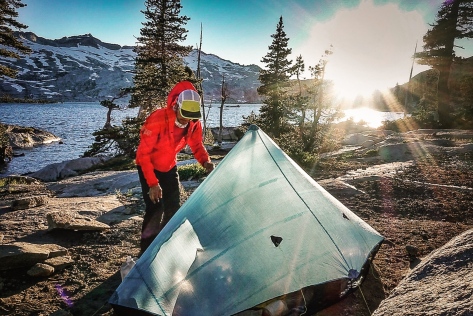
Incidentally, I did try out a bivy sack made by Katabatic Gear, the Bristlecone Bivy. I loved that thing. It kept everything clean and creepy crawlies off me while cowboy camping. The issue I had with it was condensation. Eventually, I toughened up and simply cowboy camped on my polycro groundsheet when there weren’t mosquitoes or risk of rain, otherwise, the Hexamid would go up.
Update for 2020:
The Zpacks Hexamid Solo is no longer made, but there is a lighter option available. In conjunction with a quilt like the Katabatic Alsek, I would try a bivy again. Something like the Borah Gear Cuben Bivy at 4.5 ozs could reduce drafts, make the setup bug proof, simpler and little warmer, and help keep cowboy camping cleaner and more organised. I would wash it to remove any DWR, which might improve the breathability and reduce condensation. (Thanks to ‘Nemo’ for this suggestion).
In conjunction with the bivy, I would get a shaped tarp shelter, the Zpacks Hexamid Pocket Tarp with doors. The PCT is pretty dry, so the shelter would only go up in case of rain, or in campsites where I might want a little more privacy. It’s 5.2 ozs, and together with the bivy, the whole shelter setup would weigh 9.7 ozs.
Update for 2023:
I’ve got a ZPacks Duplex for my wife and I. We’re small people, so we don’t have an issue with the size of the Duplex.
Pillow
The only extra clothes I have to make up a pillow is my rain jacket, and that was not enough. I carried and used a Sea to Summit Aeros ultra Light Pillow the entire way. Good quality sleep is important!
Update for 2020: No change. I would still use the same pillow.
Update for 2023: The Sea to Summit Aeros disintegrated. I’ve now got a Klymit X Inflatable Pillow that weighs and costs less.
Backpack
I used the Hyperlite Mountain Gear Southwest 3400. I liked it a lot. It fit me perfectly and I had no issues with it during my hike. The pack is effectively waterproof. I didn’t need to use a liner. I used ZPacks shoulder pouches for my iphone, which I used for navigation and entertainment, and my camera. It’s still in good condition and would probably serve me if I were to do another through-hike.
I would caution about buying a pack without being able to try it on, and/or have feedback about the fit. It would be best to get to a store to try it on, or otherwise be ready to exchange it if it doesn’t. From their website, Hyperlite recommends a size M, but when I went to a store to try on the pack, the Medium was way too small, and the Large fit me perfectly. Backpack fit is important, and with a pack like the the Hyperlite with nothing to adjust except the waistbelt, it either fits you or it doesn’t. There is nothing to adjust to make the pack fit a longer or shorter back length.
If I were to do another through-hike, I would go with a backpack from Hyperlite, but I may go with the smaller 2400 size instead of the 3400, and perhaps the Windrider instead of the Southwest. White or Black? I’d go with white to save a little weight, and I like to think it might help to keep the interior a little cooler, in case you have perishable food, like cheese, inside.
Update for 2020: Hyperlite has the new Junction backpacks. I would get one of those, either the 3400 or 2400, depending on the volume of my gear.
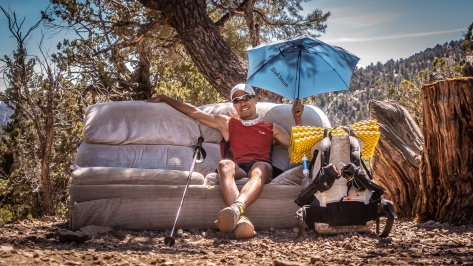
Umbrella
I started out with the Montbell Travel Umbrella, a 3 oz ultralite umbrella. I lost that umbrella and replaced it with the Euroshirm Litetrek Chrome automatic Umbrella, which weighed double at 6 ozs. I didn’t notice a difference with the chrome in the sun, but the added weight was very noticeable. I would do the Montbell Travel Umbrella again. Get the dark blue color. It blocks out the sun better.
The advantage of a sun umbrella over a wide brim hat is that you can position the umbrella to shade your upper torso, whereas the sun hat (unless the sun is directly overhead) just shades your head. The small size and light weight of the Montbell umbrella allowed me to handhold the umbrella, and position it as required to maintain shade. Another advantage to holding your umbrella is that if a gust hits the umbrella, you can angle it to spill the wind and save your umbrella from damage.
I used my umbrella from about 8am til about 4pm in the desert. I don’t think I could have continued to hike throughout the day without it.
Update for 2020: Still the same
Update for 2023: Skip the umbrella. I’ve got a sunshirt. See below…
Puffy Jacket
I found the Mountain Hardwear Ghost Whisperer on sale and switched out my The North Face Thermoball Hoodie purely to save 6 ozs of weight. The Goose Down filled Ghost Whisperer also packed smaller than my Thermoball, so I saved some space as well. Given how dry most of the PCT is, I would do the down filled Ghost Whisperer instead of a synthetic fill puffy again. I carried a fleece for a couple of weeks in the Sierras, but could have done without it, otherwise, my puffy was the only jacket I carried.
Update for 2020: No change. The Ghost Whisperer is still the puffy to get for the PCT.
Shirt
I used a lightweight tank top in conjunction with The North Face Impulse Active 1/4 zip top for most of my through-hike. Briefly, I did try a fishing shirt because I was concerned with mosquitoes in Northern Cal and Oregon, but that didn’t work for me. Basically, when I was hot, I wanted the minimum clothes to stay cool, and the tank top was the ticket. All I could do with my fishing shirt was to roll up the sleeves. The Impulse Active 1/4 zip top was the ideal companion. I wore this mostly to sleep and start the hike with in the early morning. I found it easy to pull up or pull down the sleeves to adjust quickly to temperature changes, and the thumb holes provided a quick way to keep my hands warm.
Update for 2023:
I’ve seen sunshirts in use, but could not believe that they would keep me cool. I’m now a believer and use the Outdoor Research Echo Hoodie for Men, or for Women for almost all outdoor activities. It works well in almost all conditions except in warm, humid conditions when there’s no sun. It’s kryptonite is velcro, and tends to snag and pill. Otherwise, it would be a great choice for the PCT.
Leggings
I was deciding between running tights and leggings, and brought a very old pair of Patagonia Lightweight Capilene leggings. I only wore them to hike with on the very few occasions where the cold warranted it. It was most useful to wear at night to keep my sleeping bag clean, and to beef up the warmth a little. The version I used is no longer made, but the newer Patagonia Capilene Air Leggings look like a good bet.
Wind Pants
I had never used wind pants prior to hiking the PCT. I always used rain pants. Wind pants are significantly lighter, breathe better, but are not waterproof. Given how dry most of the PCT is, wind pants seemed like a good bet. It did rain on me a few days and I was wet and cold. The advantage of wind pants is that they are comfortable to wear while sleeping to keep the sleeping bag clean and add a bit of warmth. In the morning, I could just start walking with the wind pants on while I warmed up. I used Patagonia Houdini wind pants.
Update for 2020: Montbell has changed out the fabric for their Versalite Rain Pants to a GoreWindstopper fabric coated with a waterproof/breathable laminate. They weigh about the same as the Patagonia Houdini windpants but are waterproof/breathebale and offer more protection . I’ll be getting a pair to try out and will report back.

Rain Jacket
I used a couple of different rain jackets while on trail. I started out with an old North Face jacket and then changed to a Salomon jacket, which was provided to me free as a P3 hiker for the PCTA. Both worked fine. I’ve since replaced them with an Outdoor Research Helium II Jacket. The Helium is lighter, has waterproof zips, but no handwarmer pockets. I wear my rain jacket quite a bit, as I use it for a wind breaker, and I miss the hand warmer pockets to stuff my gloves into.
Update for 2020:
Camera
I carried and used a Sony RX100 for my 2018 Thru-Hike. I used the RX100 IV for Southern California, until I dropped and broke it, and the the RX100 V for the rest of the trip. The photos you see on this post were taken by those cameras. I also used my iPhone 7 plus with a Moment Fisheye lens for a few shots. A separate review on my camera gear, along with some tips and techniques, is available here. The cameras have all been updated since I did my through-hike, and if I were to do the PCT again in 2019, I would carry and use the newer Sony RX100 VI. The longer reach (24-200mm) would be useful for wildlife.
Update for 2020:
Solar Charger and Battery Pack
I carried and used the ultralight Suntactics S5 Solar Charger to charge an external battery pack, and used the battery pack at night to charge my devices. That worked well for me for the whole of California. From about Ashland, Oregon, there was too much smoke from nearby fires, and dense forest tree cover, and the solar charger ceased to be useful. I then switched to a Quick Charger with a compatible 10,000 mAh battery pack which worked well for the rest of the trail. A Qualcomm Quick Charge battery will charge up fully it in about 3 hours, which is about the length of a typical town resupply stop, while a similar capacity normal battery could require about 8 hours, or overnight, to fully charge.
I was on-trail at the time, and didn’t have enough time to do my own research, so I bought the setup that was recommended by Neemor: The Anker QuickCharge 3.0 wall charger, with a RavPower 10,000 mAh Quick Charge Input Battery.

If I were to do the PCT again in 2019, I would skip the Solar Charger and just use the quick charge setup. 10,000 mAh was enough to keep my electronics charged up for about 4 days of normal use, which means I would need to reach town on the 5th day to charge up my battery and devices. On sections longer than 5 days, I would either try to conserve power, use a slightly bigger capacity battery, or carry a 2nd battery as backup.
Update for 2020: Same. No solar panel.
Ice Axe
I carried and used an ice axe from Horseshoe Meadows to Lone Pine, which meant I used it for summiting Mt. Whitney and getting over Forester Pass. A lot of people were getting up and over Whitney without an ice axe and some without even Microspikes. Personally, I was happy to have my ice axe on Mt. Whitney , and felt it would have been sketchy without it. I mainly used it for self-belay ( plunging the spike end into high angle snow).
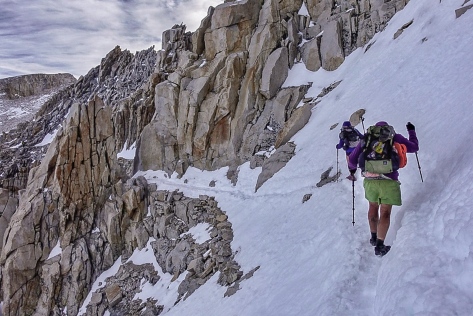
When I got to Forester Pass, which looks frightening in photos, I felt was fine without the ice axe, and so I got rid of it at Lone Pine.
What ice axe to use? I used the same ice axe that I used to summit Mt. Everest, which is a Black Diamond Raven Pro, 65cm length, but if I had to buy one for the thru-hike, I’d get the Camp Corsa in about a 50-60cm length.
Microspikes
I did carried and used Kahtoola Microspikes from Horseshoe Meadows until Kennedy Meadows North, where I sent them home with my Bear Canister. The Microspikes did the job, and are light weight. I would use those again.

Stove
BRS-3000T Stove – It weighs an unreal 25g, that’s under an ounce! And, it’s cheap! Quality control is poor. When I got mine, I had to blow out titanium dust in the valve where they drilled through before it would work. Make sure you test yours if you decide to get one before hitting the PCT.
Update for 2020: I’m still using the same stove.
Pot
I used the Toaks 650ml Titanium Pot, which was the smallest pot I could find that could hold a small fuel canister, BRS-3000T stove, mini Bic lighter and homemade alumimum windscreen. It’s a little small for cooking up a big packet of ramen like my favourite Shin Noodles, so I need to top up with a little water after taking a few slurps of it.
16oz Nalgene Wide Mouth
The idea was to use this as a hot water bottle and a ‘roller’ for when I hit town. I never used it as a roller. This broke about half-way through the journey. I simply replaced it with a 20 oz Powerade bottle and saved over an ounce of weight. I used the Powerade bottle for cold instant coffee and drink mixes (Mio, Crystal Light).
Update for 2020: Skip the Nalgene.
Water Filter
After watching a video by Darwin on water filters, I went and bought the Hydroblu Versa Flow water filter. I liked it a lot. It screws onto soda or mineral water bottles (not Smart bottles, however!) and can be back flushed by simply screwing a clean bottle onto the reverse side. The flow rate is pretty good as well. I used it by simply filling my bottle from a water source, and then attaching the filter to the bottle and squeezing the bottle to filter water into a 20 oz Powerade bottle, unscrewing the filter after each squeeze to ‘burp’ air back into the bottle and squeeze again.
Update for 2020: Sawyer has the new Micro Squeeze. I haven’t used this yet, but that’s what I’d go with for 2020.
Update for 2023:
I’m now using the Katadyn Befree water filter with 1.0l bladder for both backpacking and bikepacking.
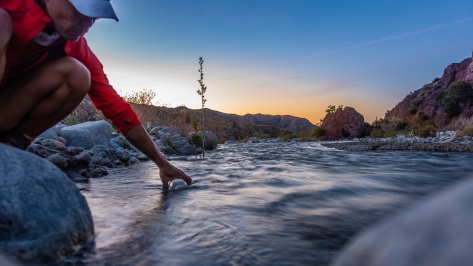
Water Bladder
I carried a 2 liter Platypus Ultra light Collapsible Water Bottle that I found in a hiker box at Scout and Frodos, and used it til the end of the hike. It weighed a little over an ounce, and was super useful to beef up my carrying capacity and to carry water to camp.
Update for 2020: Still the same.
Shoes
I started out using the Altra Lone Peak 3.5. I noticed they would lose their cushioning after about 400 miles, and even though the outsole could still last another couple of hundred miles, my feet would hurt. After my second pair wore out, I tried out the Altra Olympus 3.0. I liked those better because they had more cushioning, and my feet didn’t hurt as much. The only problem was that the outsole didn’t last very long. After about 350 miles, they were pretty much done. I would still use the Altra Olympus if I were to through-hike the PCT again, but I would be on the lookout for something with as much cushioning, but last a bit longer.
Shoes are very personal. If I were to advise someone starting a through-hike and looking for a pair of shoes, I would suggest you start wearing those shoes (and the backpack) on your training hikes. Sometimes, feet take a while to get used to new shoes. Trail runners seem to be the most popular choice on the PCT. The downside is that they don’t last very long and need to be replaced a few times during the through-hike. I went through 5 pairs of shoes. Boots, which have firmer cushioning, seem to last longer, although by Washington, I didn’t see very many through-hikers with boots.
Update for 2020: I tried the Lone Peak 4.0 but wasn’t impressed, and switched back to the Altra Olympus in 2019. I’ll be trying out the new Altra Timp 1.5, but my advice above still stands.
Update for 2023: I’ve been using the Inov8 Men’s Trailfly G270 (formerly known as the Ultra Terra G270) for a while and have been impressed by the grip and traction of the outsole, the longevity of the cushioning and the quick drying uppers. Downsides are that the uppers are not that supple and the shoe needs to be worn with socks to avoid abrasion, and they are not as wide as the Altras. I’m been off the Altras for a while, and been put off by the inconsistent changes of the same model from year to year, which include sizing.
Gaiters
I used Dirty Girl gaiters. They kept stones and debris out of my low-cut trail runners but did nothing to stop my feet from getting dirty! I’ve had issues with other brands of trail gaiters rubbing and irritating my shin, but the Dirty Girls were fine. They weigh very little and I would use them again.
Update for 2020: Same.
Beanie
This would depend on whether I was using a quilt or a sleeping bag. My sleeping bag has an integrated hood, so I didn’t need a beanie. My Buff was good enough when used in combination with my hooded puffy jacket, so I sent my beanie home after the Sierras. If I were to use a quilt, I would definitely get a good and warm beanie, and also a Buff for my neck, to sleep in. A warm beanie might weigh 2-3 ozs, so you should factor that in when accounting for the weight savings of a quilt.
Update for 2020: No beanie. If I was using a quilt, I’d get a down hood for sleeping. The buff, in conjunction with the integrated hood from my puffy jacket, provide enough warmth while out of my sleeping bag.
Sunhat
Update for 2023:
Im using a Headsweats Visor in conjuction with the Sun Hoodie. Shades my face, while providing maximum ventilation, unless the sun’s overhead, then I’ll pull over the hood for sun protection.
Gloves
These were another item that I switched 3 times. I started out with polypro liner gloves. These were thin, light, but not really warm enough. Then I changed to fleece gloves for the Sierras. Those were thicker, and really too warm for me in most situations. Finally I bought a pair of Manzella Silkweight Ultratouch Gloves. Those were the ‘Goldilocks’ gloves, not too cold and not too warm; not too thin, and not too thick. While I wouldn’t call those gloves warm, they were dextrous and suited my needs and I would use those again.
Headlamp
I started the trail with the rechargeable Black Diamond Iota. This was bright enough for night hiking but didn’t have a red light for use in camp without disturbing others. I switched to the Petzl E+Lite. This had a red light, and was crazy lightweight, but was not bright enough for night hiking. What would I use if I were to through-hike the PCT again? I would get the Petzl Bindi. It has a rechargeable battery, is bright enough to night hike, has a red light, and is pretty lightweight.
Update for 2020: I’m using and recommend the Petzl Bindi.
Knife
I used the tiny Victorinox Classic SD Swiss Army knife. The tiny blade is enough to cut open an avocado, the scissors are useful for opening packages, and the tweezers are also serve as a makeshift screwdriver to tighten up my sunglasses.
Update for 2020: I’m still using the same knife.

Calf Compression Sleeves
I started getting shin splints somewhere in Washington. I was making some pretty big mileage days by then, and I probably should have taken more zeroes, but the end was so close, that I felt compelled to hike through the pain. I was hiking with Keith Forsyth, aka ‘Old Timer’ who lent me a pair of Calf Compression Sleeves to try, and I thought they helped. My wife, who came up to meet me at Snoqualmie, brought me my old pair of Compressport R2 Calf Compression Sleeves. It was something I’d owned for a long time but never really saw any benefit. Well, I’m a believer now, and if I were to through-hike the PCT again, I’d bring these from day one. I think they helped mitigate some lower leg issues, and never got in the way of hiking. Mine were the older version of the Calf Sleeves, which I ripped on the last day on trail. I’ve since bought the newer Compressport R2 V2 Calf Compression Sleeves, which is also supposed to help with knee issues.
Shorts
I had been training with running shorts and although I found them super comfortable to hike in and sleep in, I was worried about the durability. I chanced upon Florian Astor’s PCT blog and tried his suggested Speedo swim shorts. I liked having the pockets and the fast drying, tough material, and they were comfortable enough that I made the swap. They survived the hike and I’m still using them today!
Update for 2020: I’m still using the same pair of Speedo swim shorts and I bought 9 more pairs! I’ve got them in a bunch of different colours, but the lining on the coloured ones are white, and I’d suggest going with the black shorts as the lining is also black. I’m using them as running shorts, gym shorts, climbing shorts, pyjamas… you get the idea. Compared to running shorts, they don’t have the same freedom of movement, and they are a little tight around the legs. On trail, I just fold up the bottom edge to give me a little more freedom of movement. The upside is that when glissading, they won’t ride up your butt like running shorts will!
Leggings
I used an old pair of lightweight Patagonia Capilene leggings, no longer available, but the Patagonia Capilene Air Bottoms look like a good bet.
Update for 2020: Patagonia Capilene Air Bottoms.
Trekking Poles
I used REI Carbon Flash Trekking Poles. There are lighter poles available on the market, like those used by ultra runners, but they aren’t strong enough to be used with my shelter, which needs a single trekking pole. I used the women’s version. They were just tall enough to put up my shelter, and weighed a bit less than the men’s. If you are deciding between one or two poles, two are better for creek crossings and climbing hills, but even a single trekking pole is helpful.
Socks
This one is easy. Just get Darn Toughs. The main reason is that socks are going to wear out, just like shoes, and you are going to have to get them replaced on trail, which you can do at a number of places along the way. I used the Darn Tough 1/4 Cushion Sock, which was lightweight, and cushioned. I don’t use liner socks. Over the years, I’ve found they create more problems with bunching up between the layers. My feet are pretty tough though, and I didn’t get a single blister on trail. 2 pairs are enough. I use one pair for the day, and at the end of the day, if there is water, I’ll wash that pair and use the 2nd pair to sleep with and hike with the next morning. I’ll safety pin the wet pair to the outside of my pack to dry out while I hike.
Update for 2020: Still Darn Toughs.
Diphenhydramine (Benadryl)
What it is: antihistamine
What’s it for: allergies, insomnia, motion sickness
Dosage: 25-50mg, 3-4 times a day
Side effects: drowsiness
Prednisolone
What it is: steroid
What’s it for: severe allergic reaction
Dosage: 10mg once
Side effects: nausea, vomiting
Ibuprofen
What it is: anti-inflammatory
What’s it for: fever, pain or inflammation
Dosage: 200-400mg, every 4-6 hours
Side effects: kidney failure (stay hydrated!)
Ultracarbon
What it is: charcoal
What’s it for: Diarrhoea & poisoning
Dosage: 2-4 tablets, 3-4 times a day
Side effects: binds to vitamins, medication in stomach, nausea, constipation
Diphenhydramine (Benadryl)
What it is: antihistamine
What’s it for: allergies, insomnia, motion sickness
Dosage: 25-50mg, 3-4 times a day
Side effects: drowsiness
Wound wipes
Triple antibiotic
Zanfel
Voltaren
Shit Shovel
Duece of Spades – Just get one!
A list of all my gear with weights is here on Lighterpack:
https://lighterpack.com/e/btidd6
Edited: multiple times to include more gear and currently updating for 2020
Disclosure: This post contains affiliate links. I may get a small commission if you purchase an item using these links. It won’t cost you any more, but the commissions go towards helping to keep this site running.

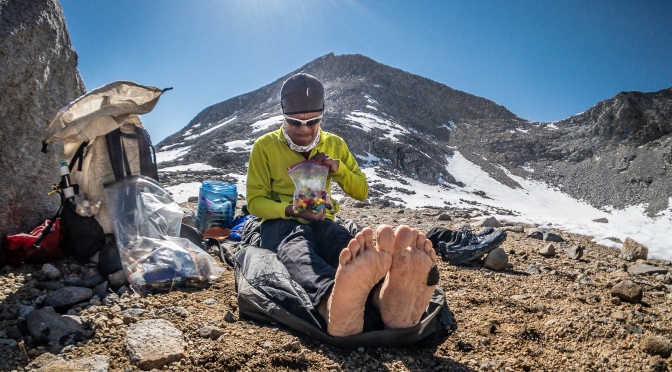
Hey Dana, hope I’m not too late. I accidentally posted my reply to you as a new comment. I’ve only used the red and blue Montbell, and the blue was cooler under the canopy. The red allowed more light through, but it was distractingly red and felt warmer. I haven’t tried the White. I did read some stuff that the dark color absorbs more light, and light colors let more of it through.
I’ve only used the red and blue Montbell, and the blue was cooler under the canopy. The red allowed more light through, but it was distractingly red and felt warmer. I haven’t tried the White.
hi Ken- Thanks so much for your thoughtful posts. Question about the umbrella: I have a chrome dome, which I like in the hot sun but it weighs 8 oz! I love the idea of a 5oz weight savings with the Montbell, but wonder about the cooling properties of a dark blue umbrella. On their website, Montbell says use white for sun. Can you comment on this more? Thank you very much!
Hi Marc, I used the Hyperlite Mountaineering Southwest 3400. Hyperlite recommended a size M, but when I went to a store to try on the pack, the Medium was way too small, and the Large fit me about perfect. Backpack fit is important, and with a pack like the the Hyperlite with nothing to adjust except the waistbelt, it either fits you or it doesn’t. There is nothing to adjust to make the pack fit a longer or shorter back length. I liked mine a lot, because it fit me. I would be best to get to a store to try it on, or otherwise exchange it if it doesn’t. I was able to try the pack on in a store and so I knew the fit would be good. I had no issues with it during the hike. I’ll update my post to include the backpack. Thanks for your feedback!
Oops typo in mail address
Hi Ken, terrific overview.
Can you explain what backpack you where using and how it performed(much like your reviews above)?
Regards
Marc(PCT thru-hiker 2019 🙂 )